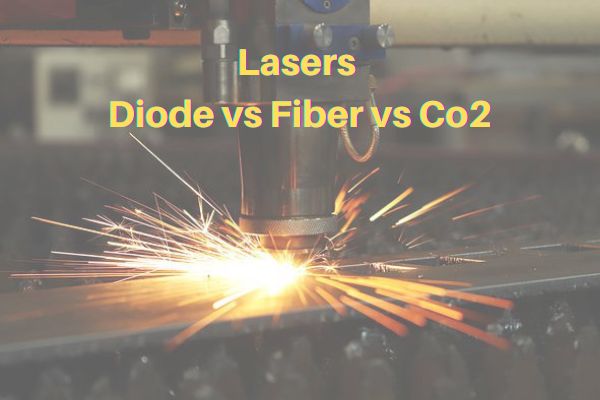Difference between Fiber Lasers vs Diode Lasers vs Co2 Lasers

The most commonly used laser systems for industrial applications like welding, cutting , marking and material processing are namely CO2 laser, Fiber laser and Diode Lasers. Each of them have their pros and cons and depending on your applications you should choose the right laser .
Lets just look at few of them briefly :
High Power Diode Lasers : Diode lasers are typical semiconductor lasers where the laser is generated in a p-n junction diode. To generate multi kilowatt power the several laser diodes are stacked together to form diode laser bars. The conversion efficiency of diode lasers can go up to 52% in several cases. Combined with 900-1100 nm wavelength , high power, stability and homogeneous beam diode lasers are used mainly for laser welding , laser cladding and laser hardening applications. These lasers are very robust and have a long life time and are most suited for heavy production in industrial environments. For many applications like cladding, hardening, brazing, plastic and metal welding diode lasers are more suitable than fiber and CO2 lasers.
Fiber Lasers : As the name suggests, here the laser is generated inside an optical fiber made of silica glass which is doped with some rare earth elements like erbium, ytterbium, neodymium etc. Fiber lasers have high conversion efficiency in the range of 35-40% and very good beam quality. Since there are very few optical elements, they require less maintenance and are robust. Also the laser beam can be delivered right upto the processing point though optical fiber giving these lasers immense flexibility. Combined with 1 micron laser wavelength (easily absorbed in most of the metals like steels) fiber lasers have today become the goto lasers for cutting, marking, drilling applications, They also find increased uses in many welding and high power applications. The operational cost of using fiber lasers is much less than CO2 lasers.
CO2 Lasers : These were the earliest lasers made which were used for material processing. Basically the lasing action happens inside a mixture of carbon dioxide gas through electric discharge. Now a day CO2 lasers are mostly used for laser marking and cutting systems. The 10.6 micron wavelength emitted by these lasers is most suitable for marking of non-metallic materials like glass, wood, acrylic, PVC, ceramics and electronic components etc. Also laser cutting of various high-thickness materials is done with CO2 lasers.
Low wall plug efficiency, high and frequent maintenance cost of various optics and mirrors used in these lasers as well as required skill set for operating and maintaining of CO2 lasers has made them less attractive to customers and where it is possible they have been replaced by either fiber or diode lasers.
Any questions ? Feel free to contact us.



